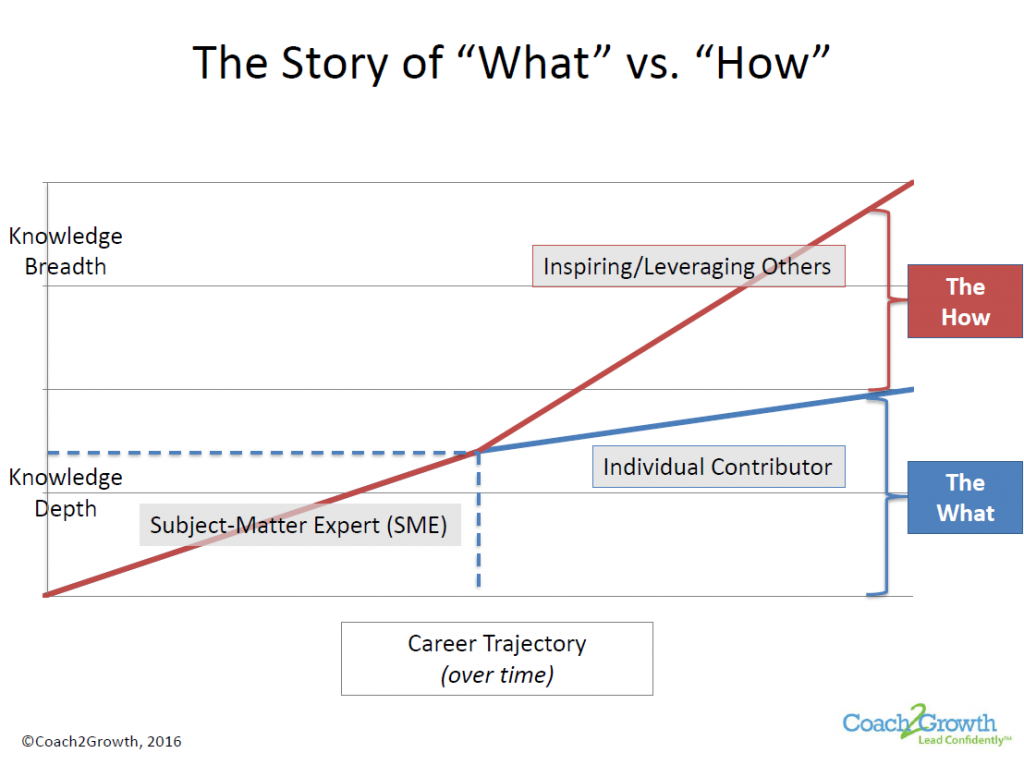I’m intrigued by the concept of leverage…the notion of getting more with less energy. Archimedes understood the power of leverage when he said, “Give me a place to stand, and I shall move the earth.” In today’s pile-it-on world, doing more with less is the order of the day, and nary a client isn’t struggling with how to keep the lever in balance.
Early in your career, you are usually hired for a specific function and/or discipline as an individual contributor. If you are a successful individual contributor, you tend to acquire an impressive depth of domain expertise. Some may even refer to you as a subject matter expert (SME). You are respected and recognized for the value of what you know. All good.
Yet, as a SME, there really is only so much any one super human can deliver alone. And at some point, you may be ready to take on more responsibility and extend your value and contribution.
There are two approaches to enhancing your value:
- Delving deeper with knowledge and specialization, where what you deliver remains front and center
- Leveraging your expertise more broadly, where how you inspire and develop others becomes a greater portion of your value-add
These paths, of course, are not mutually exclusive, but the weight of their importance varies depending on your interest, aptitude, and aspirations. While many ingredients go into the how side of the equation, here are three critical requirements to move your personal impact fulcrum for greater leverage:
- Let Go and Trust Your Value. Ultimately, this means being OK with the notion of replacing yourself in your existing role. It takes self confidence and trust that there will always be a role for you to demonstrate value. Transferring skills and teaching people what you know is more art than science, but you first have to be secure enough in yourself to share freely so you can leverage your strengths in other capacities later. Also critical here is letting go of how you might have always done something and being open to other ways that someone else may complete your job or task.
- Budget time and energy to develop others …. and, minimize errors. Some of my clients
 claim they don’t have time to teach others or to fix their mistakes. “It takes too much time for me to teach someone else what I know.” The thought of lowering standards on quality or time to market runs against the grain of over-achievers. Yet, not investing time to pass along your skills and craft means you may be doing the same role indefinitely — not to mention limiting your impact. As for fixing mistakes, they will be minimal if you remain approachable and exercise a healthy degree of inspection throughout the skills transfer process.
claim they don’t have time to teach others or to fix their mistakes. “It takes too much time for me to teach someone else what I know.” The thought of lowering standards on quality or time to market runs against the grain of over-achievers. Yet, not investing time to pass along your skills and craft means you may be doing the same role indefinitely — not to mention limiting your impact. As for fixing mistakes, they will be minimal if you remain approachable and exercise a healthy degree of inspection throughout the skills transfer process.
- Restrict your work to that which you alone are uniquely qualified. Everything else should be delegated or taught to someone else, so you can free yourself up for new challenges and development opportunities. The ultimate leverage and efficiency is ensuring that the value you deliver is unique to you. If someone else can do what you are doing, it’s hard to rationalize your unique value (and likely, a lot less interesting). You can pull your head up, look around and solve bigger problems.
If you choose to invest more in the how path, “soft skills” become increasingly important as you become an enabler of others. Helping others to learn what you know requires a shift in mindset (or the base of the fulcrum, if you will).
While certainly not every manager has mastered the how, an effective leader understands how to develop others to deliver the what, freeing herself to solve broader business challenges and initiatives. The following visual is another way to look at it. Feel free to download (.pdf) as a reminder.
Share This Post:



Speak Your Mind